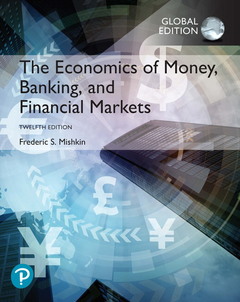The Economics of Money, Banking and Financial Markets, Global Edition (12th Ed.)
Auteur : Mishkin Frederic

For courses in money and banking, or general economics.
A unified framework for understanding financial markets
The Economics of Money, Banking and Financial Markets brings a fresh perspective to today?s major questions surrounding financial policy. Influenced by his term as Governor of the Federal Reserve, Frederic Mishkin offers students a unique viewpoint and informed insight into the monetary policy process, the regulation and supervision of the financial system, and the internationalization of financial markets. The 12th Edition, Global Edition, provides a unifying, analytic framework for learning that fits a wide variety of syllabi. Core economic principles and real-world examples organize students' thinking and keeps them motivated.
MyLab? Economics is not included.
Students, if MyLab Economics is a recommended/mandatory component of the course, please ask your instructor for the correct ISBN. MyLab Economics should only be purchased when required by an instructor. Instructors, contact your Pearson representative for more information.
Reach every student by pairing this text with MyLab Economics
MyLab? is the teaching and learning platform that empowers you to reach every student. By combining trusted author content with digital tools and a flexible platform, MyLab personalizes the learning experience and improves results for each student.
PART I: INTRODUCTION 1
1. Why Study Money, Banking, and Financial Markets?
2. An Overview of the Financial System
3. What Is Money?
PART II: FINANCIAL MARKETS
4. The Meaning of Interest Rates
5. The Behavior of Interest Rates
6. The Risk and Term Structure of Interest Rates
7. The Stock Market, the Theory of Rational Expectations, and the Efficient Market Hypothesis
PART III: FINANCIAL INSTITUTIONS
8. An Economic Analysis of Financial Structure
9. Banking and the Management of Financial Institutions
10. Economic Analysis of Financial Regulation
11. Banking Industry: Structure and Competition
12. Financial Crises in Advanced Economies
13. Financial Crises in Emerging Market Economies
PART IV: CENTRAL BANKING AND THE CONDUCT OF MONETARY POLICY
14. Central Banks
15. The Money Supply Process
16. Tools of Monetary Policy
17. The Conduct of Monetary Policy: Strategy and Tactics
PART V: INTERNATIONAL FINANCE AND MONETARY POLICY
18. The Foreign Exchange Market
19. The International Financial System
PART VI: MONETARY THEORY
20. Quantity Theory, Inflation, and the Demand for Money
21. The IS Curve
22. The Monetary Policy and Aggregate Demand Curves
23. Aggregate Demand and Supply Analysis
24. Monetary Policy Theory
25. The Role of Expectations in Monetary Policy
26. Transmission Mechanisms of Monetary Policy
CHAPTERS ON THE WEB
1. The ISLM Model
2. Nonbank Finance
3. Financial Derivatives
4. Conflicts of Interest in the Financial Services Industry
This title is a Pearson Global Edition. The Editorial team at Pearson has worked closely with educators around the world to include content which is especially relevant to students outside the United States.
Enliven students’ study of money, banking, and financial markets
- New - Chapter 1 teaches students about career opportunities available beyond Wall Street or in a bank.
- New - Chapter 4 illustrates negative interest rates in countries like Japan, the United States, and Europe.
- New - Chapter 5 shows how the supply and demand model explains current interest rate movements.
- New - Chapter 12 discusses and analyzes how the financial crises that originated in the United States also impacts other advanced global economies.
- New - Chapter 13 discusses the crisis-stricken Mexico, Thailand, and South Korea’s external debt and highlights the same using appropriate diagrams.
- New - Chapter 14 highlights major banking systems around the world—the European Central Bank, the Federal Reserve, the Bank of Japan—their origins, structure, and functions.
- New - Chapter 18 highlights an application on Burgernomics, Big Macs, and Purchasing Power Parity, as a fun way of showing students how purchasing power parity works in practice.
- Updated - Global Box in Chapter 19 helps students interpret claims made about the large US current account deficit in both the media and in Congress.
- A unifying, analytic framework uses a few basic economic principles to organize students’ thinking about the structure of financial markets, foreign exchange markets, financial institution management, and the role of monetary policy in the economy.
- A no-fuss solution for instructors who want to make the most recent data a central part of their m
Date de parution : 12-2018
Ouvrage de 744 p.
20.2x25.2 cm
Disponible chez l'éditeur (délai d'approvisionnement : 12 jours).
Prix indicatif 83,60 €
Ajouter au panier


